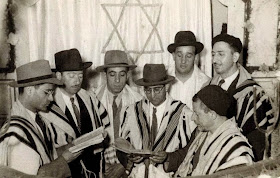2014 came and went too quickly. I wanted to post more often
but as so frequently happens, life got in the way. In lieu of my more regular
posts, I offer you, “Mazal Haï Mazal: Eight North African Tracks to Light Your
Soul On Fire,” as an end of the year treat. These are eight (one for every
night of Hanukkah) of my favorite Moroccan and Algerian tracks (mostly on vinyl
but one on cassette) and articulate a range of Maghrebi Jewish sounds - from
Andalusian to chaabi to a song about the atomic bomb! Feel free to stream, download, and share.
Consider the title of this end of the year Hanukkah mixtape
an Arabic-Hebrew play on words. Indeed for most of the mid-century North
African Jewish artists featured here, “mazal” always carried two meanings. In
Arabic, mazal meant “still,” as in Lili Labassi’s “Mazal haï mazal” (S/he’s
still alive) - a track beautifully presented on the Excavated Shellac blog. But
so too did mazal recall the Hebrew for “luck” or “fortune,” a point made by
Labassi’s disciple Blond Blond, who sang, “mazal, c’est la chance,” in what is
perhaps the only Algerian Hanukkah song ever to be recorded commercially. I say
all of this to convey the following: treat my take on Mazal Haï Mazal in both
of these senses. Not only is this music “still alive” but so too should we
remember that it is through a combination of fortune and luck (and all of our
good graces) that it continues to live on.
One last point before we get to the
music. Treat this as a soft launch of a crowd funding campaign to turn my
private record collection into a public sound archive. On my shelves are
historical audio gems that deserved to be shared and I want to make that happen
as soon as possible. In other words, keep an eye out on this site in 2015!
Best wishes for the New Year!







